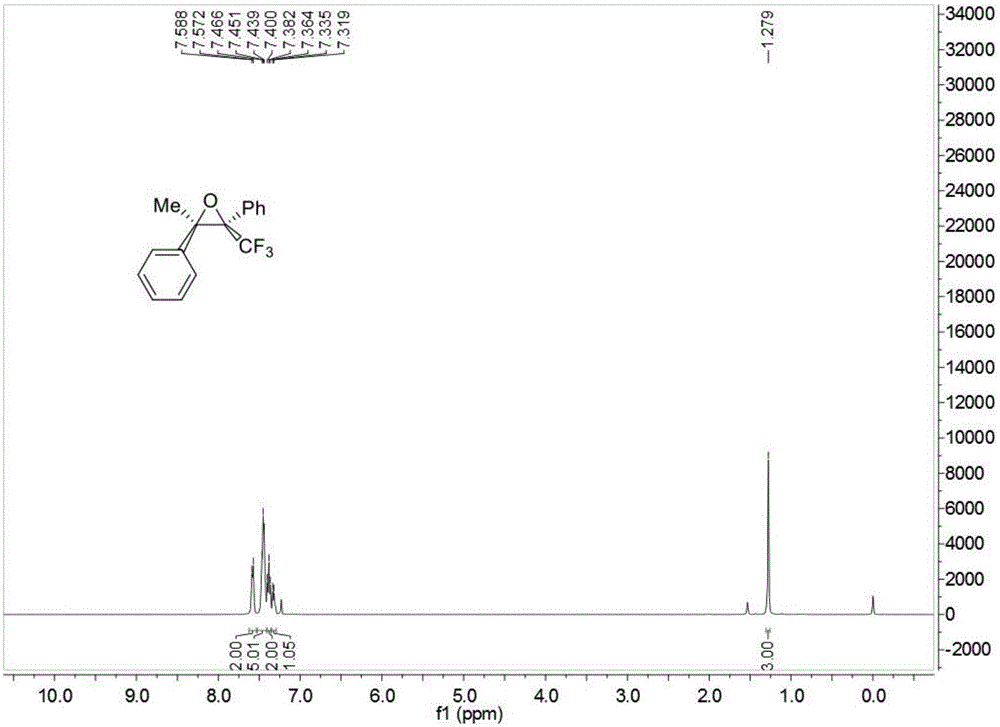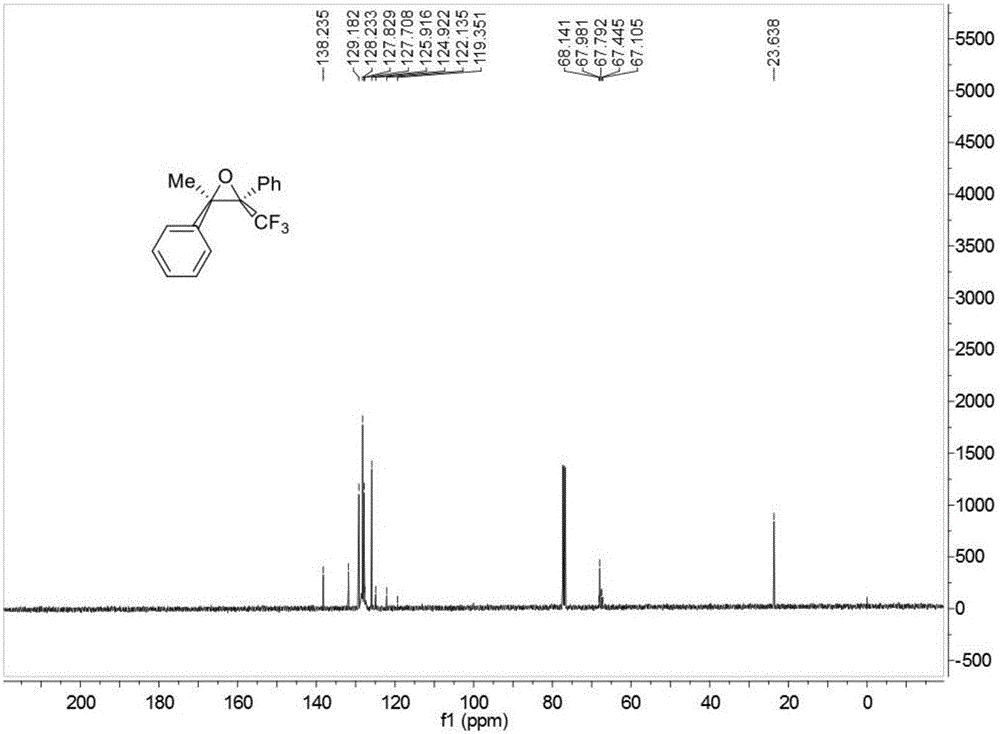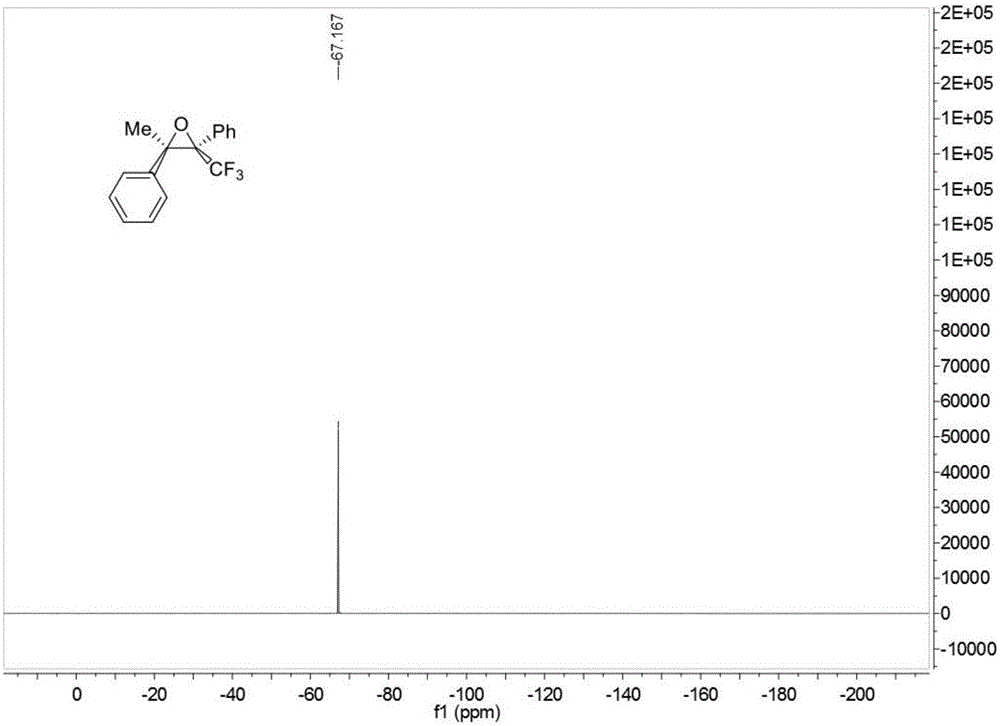Trifluoromethyl substituted continuous quaternary carbon center cyclopropane derivative and synthetic method
A technology of propylene oxide and trifluoromethyl, which is applied in the field of propylene oxide derivatives and synthesis of continuous quaternary carbon centers containing trifluoromethyl, can solve the problems of harsh reaction conditions, threats to human safety, waste of financial resources, etc. , to achieve the effect of good diastereoselectivity, good adaptability and simple operation
- Summary
- Abstract
- Description
- Claims
- Application Information
AI Technical Summary
Problems solved by technology
Method used
Image
Examples
Embodiment 1
[0030] In a 25ml reaction flask equipped with a reflux condenser, add 0.2mmol of acetophenone p-toluenesulfonylhydrazone, 0.2mmol of cesium carbonate, 0.02mmol of benzyltriethylammonium chloride, 2ml of toluene, at 25°C After stirring and reacting for 1 hour, 0.1 mmol of 2,2,2-trifluoromethylacetophenone was added, and the reaction system was stirred and reacted at 90°C for 12 hours, then heating and stirring were stopped, and cooled to room temperature. The reaction solution was extracted with ethyl acetate, the solvent was removed by rotary evaporation under reduced pressure, and then separated and purified by column chromatography to obtain the target product. The column chromatography eluent used was a mixed solvent of petroleum ether: ethyl acetate with a volume ratio of 1000:1 , the main diastereoisomer of the product was obtained with a yield of 97%.
Embodiment 2
[0032] In a 25 ml reaction flask equipped with a reflux condenser, add 0.2 mmol of acetophenone p-toluenesulfonylhydrazone, 0.3 mmol of potassium carbonate, 0.02 mmol of benzyltriethylammonium chloride, 2 ml of toluene, at 25 °C After stirring and reacting for 1 hour, 0.1 mmol of 2,2,2-trifluoromethylacetophenone was added, and the reaction system was stirred and reacted at 90°C for 12 hours, then heating and stirring were stopped, and cooled to room temperature. The reaction solution was extracted with ethyl acetate, the solvent was removed by rotary evaporation under reduced pressure, and then separated and purified by column chromatography to obtain the target product. The column chromatography eluent used was a mixed solvent of petroleum ether: ethyl acetate with a volume ratio of 1000:1 , the main diastereoisomer of the product was obtained with a yield of 93%.
Embodiment 3
[0034]In a 25 ml reaction flask equipped with a reflux condenser, add 0.2 mmol of acetophenone-p-toluenesulfonylhydrazone, 0.2 mmol of potassium tert-butoxide, 0.02 mmol of benzyltriethylammonium chloride, and 2 ml of toluene. After stirring and reacting at 25°C for 1 hour, 0.1 mmol of 2,2,2-trifluoromethylacetophenone was added, the reaction system was stirred and reacted at 90°C for 12 hours, heating and stirring were stopped, and cooled to room temperature. The reaction solution was extracted with ethyl acetate, the solvent was removed by rotary evaporation under reduced pressure, and then separated and purified by column chromatography to obtain the target product. The column chromatography eluent used was a mixed solvent of petroleum ether: ethyl acetate with a volume ratio of 1000:1 , the main diastereoisomer of the product was obtained with a yield of 94%.
PUM
 Login to View More
Login to View More Abstract
Description
Claims
Application Information
 Login to View More
Login to View More - R&D
- Intellectual Property
- Life Sciences
- Materials
- Tech Scout
- Unparalleled Data Quality
- Higher Quality Content
- 60% Fewer Hallucinations
Browse by: Latest US Patents, China's latest patents, Technical Efficacy Thesaurus, Application Domain, Technology Topic, Popular Technical Reports.
© 2025 PatSnap. All rights reserved.Legal|Privacy policy|Modern Slavery Act Transparency Statement|Sitemap|About US| Contact US: help@patsnap.com



